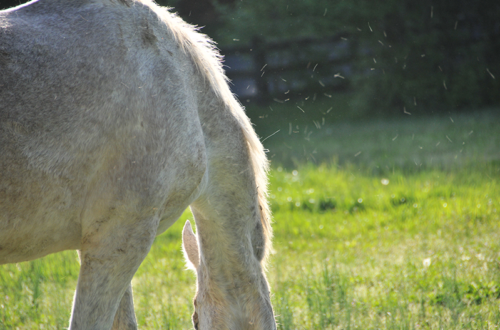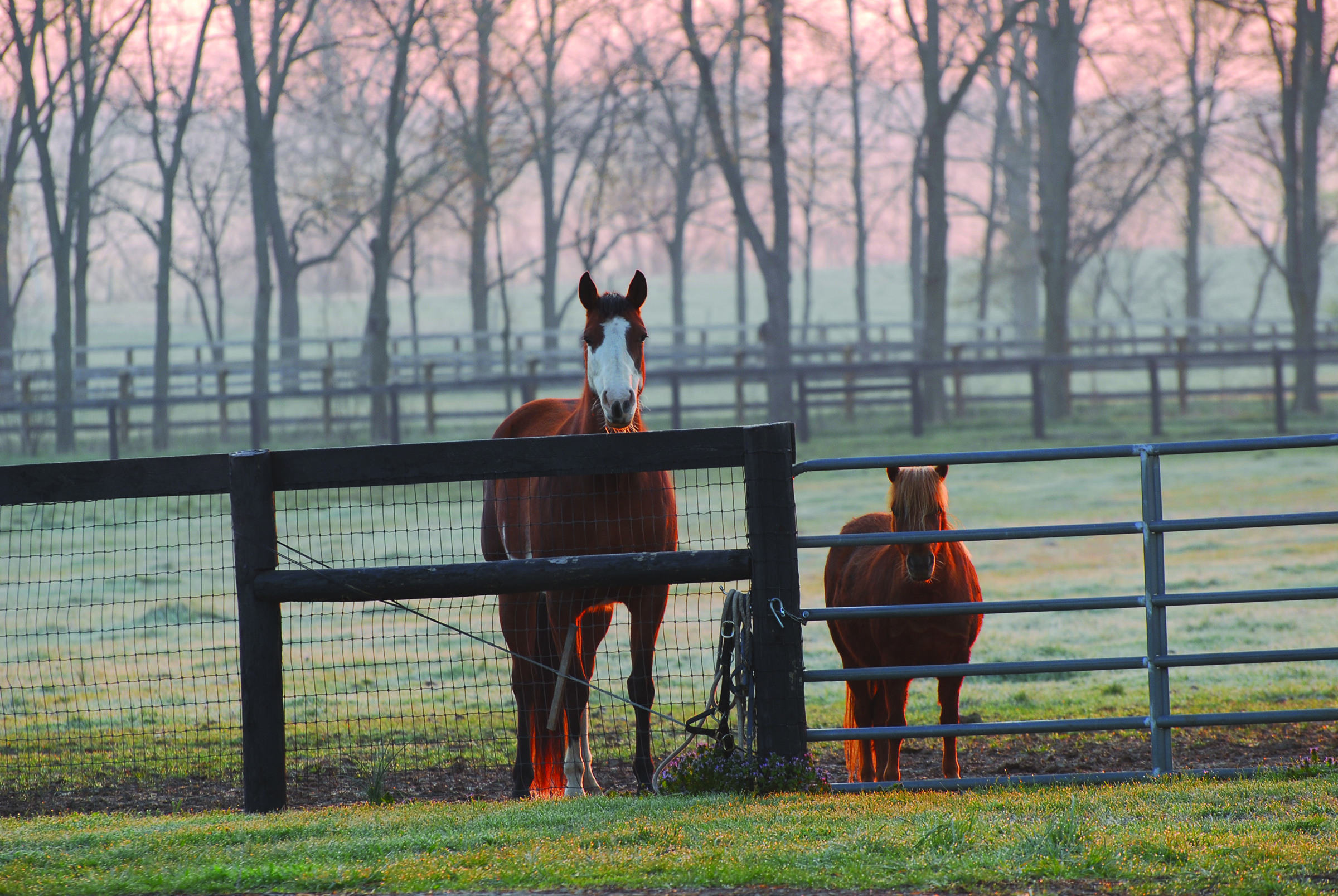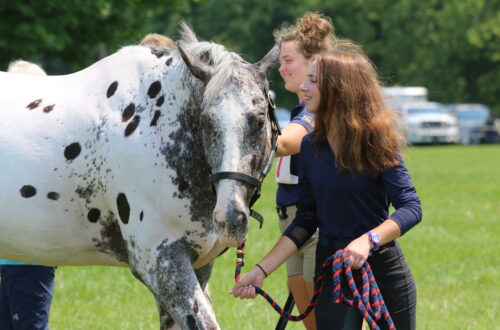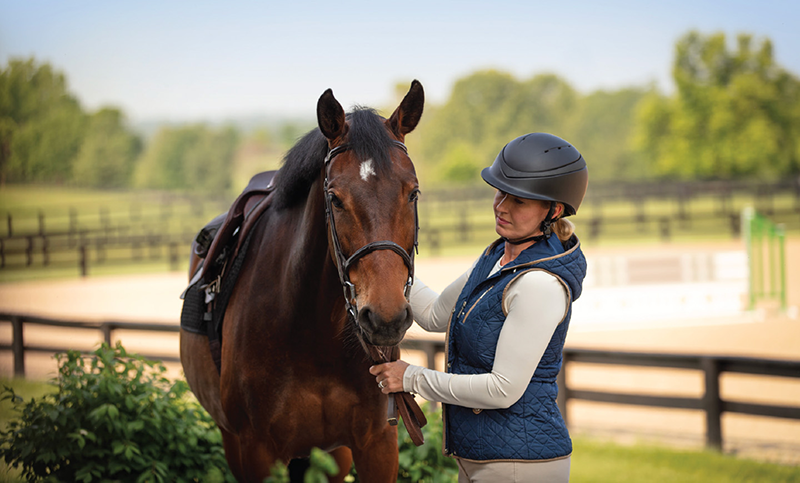
What Do Sunrises and Equine Joint Health Have in Common?
By Holly Helbig, DVM, Equine Technical Services Veterinarian, Zoetis
With the help of a grande vanilla latte, I like to get to barns early for lameness exams—I watch the sunrise, observe horses in pastures, ask questions about feeding, watering, medicating, and everything else barn staff members do at the crack of dawn. There’s always one horse kicking down the stall, demanding to be fed first or an obese mare getting that extra flake of hay because her owner insists, “She’s hungry all the time!” I observe the horse in her stall, how she banks her shavings and how she walks out into the aisleway. If it’s a routine exam or the lameness is subtle, I want to see the horse under tack. I want to see her routine, how she’s warmed up/cooled down and put through the motions of what’s expected of her. I even consider the type of footing she’s trained on.
In other words, I’m not just there to flex and palpate the horse. Joint health encompasses the entire lifestyle that our equine athletes live day in and day out. Despite technological advancements in equine science, like regenerative medicine, mind-blowing imaging breakthroughs, equine wearable tech offering 24/7 health data and AI-generated diagnostics, proper horsemanship still is and always will be a primary component of joint wellness, from sunrise to sunset.
Watch the video below by Dr. Helbig to learn more about joint care from sunrise to sunset.
Being Proactive About Joint Health
As fall approaches, many horse owners move indoors to ride and continue training. This time of year usually means less turnout, more stall confinement, tighter indoor arenas, changes in hay quality, and cooler temperatures. For many horses, it’s been a heavy show season and they’re at peak condition. Subsequently, they can also be at peak levels of soreness. This is a great time of year to reevaluate joint health and develop a strategy to maintain optimal body condition through the winter months ahead.
Regardless of the degree of lameness, joint wear and tear is part of every horse’s life. Protecting the joint structures starts early in life, and caring for them needs to change accordingly as the horse grows, trains, and matures.
Consider joint health every day:
- Regardless of your horse’s level of activity, joint health should be prioritized and evaluated on a routine basis by your veterinarian.
- Preventive joint health encompasses nutrition, weight management, exercise, supplements, proper shoeing, and everyday horsemanship skills.
- Watch for these signs: a change in performance, stiffness, shortness of stride, change of gait, and/or heat and joint swelling.
- For horses with osteoarthritis (OA), work with your veterinarian to focus on treating inflammation and slowing the progression of the disease.
Nutrition Fuels Horse Joints
Nutrition is one of the most important aspects of fueling healthy joints, and it should be focused on even before birth. As a horse ages and his workload changes, diet should change simultaneously.
Here are some guidelines to help you navigate the matrix of equine nutrition regarding joint health:
- For decades, we’ve referred to the National Research Council’s Nutrient Requirements of Horses, with sections focused on the equine athlete. An updated version from 2007 can be purchased at this link.1
- Horses do best with a forage-first diet, limiting grains when possible.
- The goal is to provide adequate energy, optimal protein levels, and balanced minerals, particularly calcium and phosphorus.
- The high levels of omega-3 fatty acids and vitamin E in green grass degrade quickly when hay is cut. A balanced supplement containing these ingredients with trace minerals, amino acids, and antioxidants can restore these lost nutrients to the diet.
- Broodmares and young, growing horses require a heightened level of diet awareness. During the last months of gestation, a broodmare has the caloric needs of a horse in heavy training and requires balanced nutrition to ensure normal fetal development.
- Stacking excessive supplements with commercial grains can cause an imbalance in vitamins and minerals. Research is key when choosing supplements.
- Maintain a healthy weight to lessen stress on horses’ joints and to avoid metabolic issues.
- If hay quality suffers in the winter months, supplement accordingly with options such as alfalfa/hay cubes, beet pulp, or ration balancers.
For more information, read Feeding Frenzy: An Equine Nutritional Revolution.
Living Well with OA
When we take a moment to think about the long-lived careers of show horses or a 30-year-old pony still teaching lessons down the road, you can’t help but appreciate the wear-and-tear those joints have had over the years. Sir Isaac Newton was right when he said, “A body in motion stays in motion,” a statement proven by award-winning human and equine athletes all around the world.
Approximately 60% of equine lameness cases are related to OA, which is often associated with a loss of performance and early retirement from athletic careers.2 Primary OA is due to chronic repetitive trauma, with risk factors including breed, age, sex, conformation (horse’s shape/body structure, which can affect his athletic ability), occupation, and systemic predispositions of the bone and cartilage.2 Joint pain involves more than just the articular cartilage. It also includes the subchondral bone, synovium, joint capsule, tendons, and ligaments surrounding the joint.
Horses with OA can present with a range of clinical signs, from subtle changes in performance to severe lameness. Identifying clinical signs early and working with your veterinarian to develop an individualized plan for your horse is key. Like many species, most horses live comfortably day in and day out with OA.
Managing Joint Pain
Until horses can sign up for yoga, there are effective ways to manage joint pain. Reducing inflammation, slowing the progression of OA, and providing comfort are the goals when treating horses with joint pain. The realm of treatments and therapies is continuously evolving, often leaving not only the horse owner, but sometimes even the veterinarian, questioning what the right therapy of choice is.
Veterinarians look at multiple factors when considering how to treat and manage your horse’s OA, such as:
- Age and breed
- Medical history
- Body condition, measuring both fat and level of muscling
- Metabolic status/history of laminitis
- Degree of lameness
- High-motion vs. low-motion joints
- Level of exercise
- Withdrawal times of medications for competitions
Inflammation can be addressed through a spectrum of therapies. Noninvasive modalities, like NSAIDS or rest, or more invasive therapies, such as intra-articular injections or surgery, have all shown to be successful in reducing inflammation. Research continues to provide more insights; scientific discoveries advance our therapy options. For example, regenerative medicine is one type of therapy that aims to replace or regenerate cells, tissues, or organs to restore or establish normal function. By concentrating high levels of growth factors and anti-inflammatory cytokines, we can provide anti-inflammatory and healing properties to joints and soft tissues. Many therapies can be combined to have an additive or synergistic response to inflammation.3
The most used options for managing and treating equine osteoarthritis include:
- NSAIDS
- General wellness and joint supplements
- Hydrotherapy
- Physical/rehabilitation therapy
- Corrective shoeing
- Shockwave therapy
- Acupuncture/chiropractic medicine
- Intra-articular therapies
- Corticosteroids with or without hyaluronic acid
- Autologous protein solutions
- Platelet-rich plasma (PRP)
- Autologous conditioned serum (IRAP)
- Mesenchymal stem cells (MSCs)
- Polyacrylamide gels
- Amnion-derived therapies
As medicine and technology continue to evolve, the end game remains the same: prevent, diagnose, and treat.
Let’s Get Physical
Once treated, proper conditioning and rehabilitation for the horse must be fulfilled. Conditioning options that have a low impact on joints can be beneficial to the horse, both physically and mentally. Take advantage of these exercises, especially during the winter when the ground is frozen or when your client is taking a break from competing—this is an optimal time to incorporate these routines into your horses’ day-to-day. Examples of low-impact conditioning include:
- Properly warming up to prepare for exercise and cooling down to recover
- Walking up and down hills for strength training
- Using trot poles to help build muscle and a strong topline
- Underwater treadmill or swimming
- Increasing frequency of days ridden while decreasing riding time
- Avoiding riding in deep, heavy snow and on hard, frozen ground (conversely, be cautious with excessive exercise in extreme heat in warmer months)
- When temperatures reach below 15°F, limiting exercise to walking and light trotting
The Off Season
Professional athletes have an off season. What about performance horses? Equine trainers and owners often walk a fine line between reaching a horse’s optimal performance and running into potential injuries. In recent years, it seems there’s been growing pressure to achieve immediate results. The accelerating pace of training technologies and techniques, as well as training surfaces, have also changed the performance versus injury landscape.
More and more show venues have readily become available to owners and trainers over the last decade. Training programs must find a balance between keeping horses conditioned, not burning out our equine partners, allowing clients to learn and practice, and sustaining a financial profit. But conditioning is also about proper rest. Stables get creative during downtime and should be encouraged to rest the horse’s joints while having a little fun at the same time! Here are some great traditions shared by clients through the years. Forewarning, adult riders don’t always participate (but tend to have a lot of fun when they do!).
- No-stirrups November
- Hanging stirrups on a tree/or a wall hook in the beginning of December and taking them off on Christmas or Hanukkah
- Bareback riding
- Horseless horseshows
- Desensitizing activities for riders to work through with their horse or pony
- Perfecting the equitation tests on usef.org
Joint health and conditioning start with the basics in and around the barn, encompassing the whole horse. Just as every sunrise is unique, if we take a little time to observe, each horse has a unique set of needs regarding joint health. There will always be advancements in medicine, but what doesn’t change is the amount of time we spend addressing preventive care and working with our veterinarians to manage our horses’ day-to-day comfort.
References
- Van Weeren PR, de Grauw JC. Pain in osteoarthritis. Vet Clin North Am Equine Pract. 2010;26(3):619-42. Accessed August 3, 2023.
- Labens R, Schramme M, Barr A. Orthopaedics 1: Diagnosis of lameness/diseases of joints and bones in Equine Medicine, Surgery and Reproduction (Second Edition). Science Direct. 2012;(15):309-28. Accessed August 3, 2023.
- Bertone AL, Ishihara A, Zekas LJ, et al. Evaluation of a single intra-articular injection of autologous protein solution for treatment of osteoarthritis in horses. Am J Vet Res. 2014;75(2):141-151. doi: 10.2460/ajvr.75.2.141.
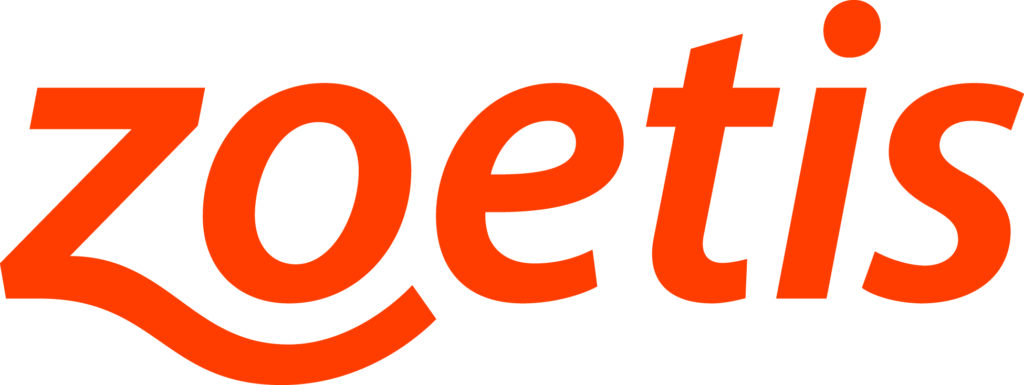
About Zoetis— Official USPC Equine Health and Wellness Partner
To learn more about how Zoetis is making lives better for horses and those who care for them, visit zoetisequine.com and Zoetis Equine on Facebook and Instagram.



